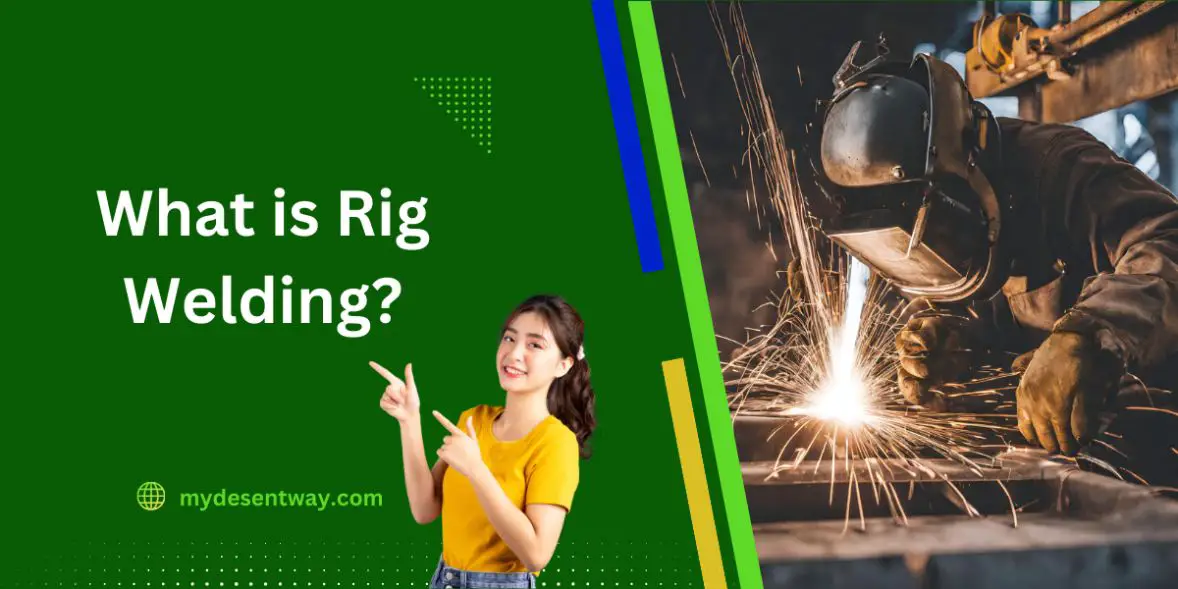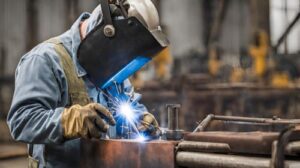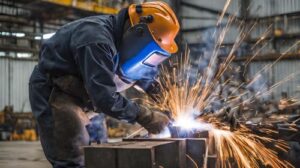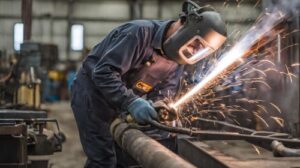Table of Contents
- What is Rig Welding?
- 1. What Does a Rig Welder Do?
- 2. Skills Needed for Rig Welding
- 3. Types of Rigs in Welding
- 4. Components of Rig Welding
- 5. Rig Welding Process Step-by-Step
- 6. Training and Education for Rig Welding
- 7. Challenges in Rig Welding
- 8. Advantages of Rig Welding as a Career
- 9. Famous Rig Welding Projects
- 10. Future Trends in Rig Welding
- 11. Safety Measures in Rig Welding
- 12. Environmental Impact of Rig Welding
- 13. Community and Networking in Rig Welding
- 14. Success Stories in Rig Welding
Have you ever wondered about the essence of rig welding – or, in simpler terms,what is rig welding. It’s this remarkable fusion of skill and artistry that underpins the solidity of structures and the success of welding ventures across diverse industries.
Here, we embark on a journey into the fascinating world of rig welding, uncovering its intricate workings, navigating through its challenges, and unveiling the exciting avenues it opens as a potential career path.
What is Rig Welding?
Rig welding is a specialized technique used in mobile or off-site welding jobs. It’s common in construction, pipelines, and maintenance, offering flexibility where stationary setups aren’t possible. This method ensures strong, precise welds in various industries.
1. What Does a Rig Welder Do?
At its core, rig welding involves the fusion of metals in the construction and maintenance of structures, with a particular emphasis on welding in challenging environments such as offshore and onshore rigs. Rig welders play a crucial role in ensuring the structural integrity of various projects, from pipelines to oil rigs.
Job Description of a Rig Welder
Job Description:
A rig welder is a skilled professional responsible for performing welding operations in various settings, often in industrial, construction, or specialized environments. They work with a variety of materials, joining metal components together using different welding techniques to create sturdy and durable structures. Rig welders may work in diverse sectors such as oil and gas, construction, manufacturing, and more.
Responsibilities:
- Welding Operations: Conducting welding tasks using specialized techniques such as arc welding, gas metal arc welding (MIG), shielded metal arc welding (SMAW), or other methods based on project requirements.
- Material Preparation: Preparing surfaces by cleaning, cutting, and shaping metal components before welding to ensure proper bonding.
- Equipment Setup: Setting up welding equipment, ensuring its proper functioning, and adjusting settings based on the type of materials and welding technique being used.
- Safety Compliance: Adhering to safety protocols, wearing appropriate protective gear, and ensuring a safe working environment for oneself and others.
- Quality Control: Inspecting finished welds to ensure they meet quality standards, checking for defects or imperfections, and making necessary adjustments.
- Documentation: Maintaining records of welding activities, documenting work done, materials used, and adhering to project specifications.
- Collaboration: Working closely with other team members, contractors, or supervisors to coordinate tasks and meet project deadlines.
Rig welders are versatile professionals proficient in various welding techniques, emphasizing precision, safety, and efficiency in their work to create strong and reliable welds within diverse industrial settings.
2. Skills Needed for Rig Welding
Rig welders must possess a unique set of skills, including technical proficiency in welding techniques, physical dexterity to navigate challenging workspaces, and a comprehensive understanding of safety protocols to mitigate potential risks.
3. Types of Rigs in Welding
Offshore Rigs:
Offshore rigs refer to welding operations conducted at sea, typically on platforms or structures located in oceans or seas. These rigs are crucial for the construction, maintenance, and repair of oil rigs, drilling platforms, and other marine structures.
Due to the challenging and corrosive marine environment, welding on offshore rigs requires specialized techniques and materials to withstand harsh conditions such as saltwater exposure, high winds, and fluctuating temperatures.
Rig welders working offshore often undergo rigorous safety training and must adhere to stringent safety protocols due to the remote and demanding nature of these environments.
Onshore Rigs:
Onshore rigs involve welding activities performed on land-based structures and installations. These can include welding in industries such as construction, manufacturing, infrastructure development, and more.
Onshore welding operations encompass a diverse range of projects, from building construction to pipeline welding. Unlike offshore rigs, onshore welding may occur in more controlled environments, allowing for easier access to resources and equipment.
However, adherence to safety protocols and standards remains crucial to ensure the quality and durability of welds in onshore rig welding.
Specialized Rigs:
Specialized rigs encompass a wide array of welding operations that cater to specific industries or unique requirements. These rigs may include welding in specialized environments such as aerospace, automotive manufacturing, nuclear facilities, and more.
Each specialized rig demands a distinct skill set, equipment, and expertise tailored to the specific industry’s standards and safety protocols.
For instance, aerospace welding necessitates precision and adherence to strict quality control measures to meet aviation standards, while welding in nuclear facilities requires stringent safety protocols due to the sensitivity of the environment.
Understanding the nuances and requirements of different rig welding types is essential for welders, as each presents its own set of challenges and demands specialized skills and knowledge. Whether it’s braving the elements on an offshore rig or adhering to strict industry standards in specialized welding, welders must adapt their skills to meet the unique demands of each rig type.
4. Components of Rig Welding
Rig welding relies on several essential components and equipment to execute precise and efficient welds. Understanding these components is crucial for ensuring safety, accuracy, and quality in the welding process:
Welding Machine:
The welding machine serves as the primary tool in rig welding, generating the necessary heat and electrical currents for welding. These machines vary in types and sizes based on the welding technique employed. They consist of power sources, transformers, and controls that regulate voltage and current to produce the desired weld.
Electrodes and Filler Materials:
Electrodes and filler materials play a vital role in rig welding by providing the material needed to form the weld. In processes like shielded metal arc welding (SMAW), electrodes are consumed during welding to create the weld pool. Filler materials, often in the form of rods or wires, supplement the base metal in creating strong, durable welds in techniques like gas metal arc welding (GMAW).
Protective Gear:
Safety is paramount in rig welding, and protective gear is essential for welders to safeguard themselves from potential hazards. This includes helmets with welding filters to shield the eyes from intense light, flame-resistant clothing to protect against sparks and heat, gloves for hand protection, and boots to shield the feet from hot materials and potential hazards.
Other Accessories:
Rig welding often involves additional accessories such as clamps, brushes, chipping hammers, and welding curtains or screens to create a safe and organized workspace. Clamps hold workpieces together securely during welding, while brushes and chipping hammers help in cleaning and preparing surfaces for welding.
Personal Protective Equipment (PPE):
In addition to specific welding gear, welders must wear appropriate personal protective equipment (PPE) as per industry standards. This includes respiratory protection if working in confined spaces or environments with fumes, ear protection against loud noises, and other safety gear as dictated by the welding environment.
Understanding and utilizing these components ensure not only the effectiveness and efficiency of the welding process but also the safety and well-being of welders and those around the welding area.
5. Rig Welding Process Step-by-Step
Rig welding involves a systematic process to ensure precise and durable metal joining. Understanding the sequential steps is fundamental for achieving successful welds:
1. Preparation:
Preparation is key in rig welding. It involves cleaning the surfaces to be welded, removing any contaminants like rust, paint, or dirt. Proper cleaning ensures optimal welding conditions and a strong bond between metals.
2. Setting Up Equipment:
Setting up the welding equipment is the next crucial step. This includes assembling the welding machine, ensuring the electrodes or filler materials are in place, and configuring the settings according to the material and welding technique being used.
3. Executing the Weld:
Once the setup is complete, the welding process begins. It involves striking an arc or initiating the welding process based on the chosen technique. The welder carefully manipulates the welding tool to create the weld bead, ensuring proper penetration and fusion of the metals.
4. Monitoring and Adjusting:
Throughout the welding process, monitoring the weld bead’s quality is essential. Welders assess factors like the appearance of the weld, bead size, and penetration depth. Adjustments to the welding parameters may be necessary to achieve the desired weld quality.
5. Cooling and Inspection:
After completing the weld, allowing sufficient time for the welded joint to cool is crucial. Once cooled, a thorough inspection is conducted to assess the integrity of the weld. This inspection involves checking for any defects, such as cracks or incomplete fusion, and ensuring compliance with welding standards.
6. Finishing:
The final step involves any necessary finishing touches, such as grinding excess material or smoothening the weld surface to meet specific dimensional requirements or aesthetic standards.
Mastering each step of the rig welding process is vital for welders to produce high-quality welds consistently. Attention to detail, precision, and adherence to safety protocols throughout these steps ensure the reliability and durability of the welded structures.
6. Training and Education for Rig Welding
Becoming a proficient rig welder requires a combination of formal education, certification, and practical experience. Rigorous training programs and apprenticeships provide aspiring welders with the necessary knowledge and hands-on skills.
7. Challenges in Rig Welding
Despite the allure of rig welding, it comes with its share of challenges. Harsh working conditions, safety concerns, and physical demands require resilience and a commitment to adhering to best practices.
8. Advantages of Rig Welding as a Career
For those embarking on a career in rig welding, the rewards are plentiful. With a high demand for skilled welders, competitive salaries, and opportunities for travel, rig welding offers a fulfilling and financially rewarding career path.
9. Famous Rig Welding Projects
Rig welding has left an indelible mark on various iconic structures and notable achievements. From towering skyscrapers to intricate bridges, the fingerprints of rig welders can be found in structures that define modern engineering.
10. Future Trends in Rig Welding
As technology continues to advance, rig welding is not immune to innovation. The industry is witnessing changes in welding techniques, automation, and the integration of digital tools, shaping the future of rig welding.
11. Safety Measures in Rig Welding
Safety is paramount in rig welding. Strict adherence to safety protocols and the implementation of common safety practices are integral to the well-being of rig welders and the success of welding projects.
12. Environmental Impact of Rig Welding
Acknowledging the environmental impact of welding, rig welders are increasingly adopting sustainable practices. Mitigating environmental effects and embracing eco-friendly approaches contribute to a greener and more responsible welding industry.
13. Community and Networking in Rig Welding
Building a network within the rig welding community is crucial for professional growth. Engaging in industry events, joining associations, and fostering relationships with peers create a supportive community for rig welders.
14. Success Stories in Rig Welding
The world of rig welding is dotted with success stories. Profiles of successful rig welders serve as inspiration, showcasing the possibilities and achievements within this dynamic and ever-evolving profession.
Conclusion
In conclusion, rig welding is not merely a profession; it’s a journey of skill development, overcoming challenges, and contributing to the creation of lasting structures. Aspiring rig welders should embrace the opportunities, continually enhance their skills, and become part of a community that shapes the future of welding.
FAQs:
Is rig welding a physically demanding job?
Rig welding can be physically demanding due to the nature of the work and the environments in which welders operate. However, proper training and physical fitness can mitigate the challenges.
What is the future outlook for rig welding careers?
The demand for skilled rig welders is expected to remain high, with technological advancements and industry changes opening up new opportunities for those entering the field.
How long does it take to become a certified rig welder?
The timeline to become a certified rig welder varies, but it often involves a combination of formal education, apprenticeship programs, and gaining practical experience. On average, it may take a few years.
What safety measures should rig welders prioritize?
Rig welders should prioritize safety by following strict safety protocols, wearing protective gear, and staying updated on industry best practices to minimize risks associated with the job.
Rig welders are increasingly adopting sustainable practices to address environmental concerns. Minimizing emissions, proper waste disposal, and using eco-friendly materials contribute to a more environmentally conscious approach in rig welding.



